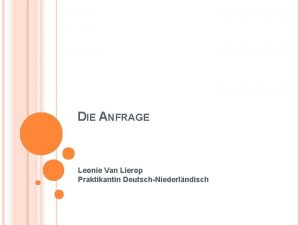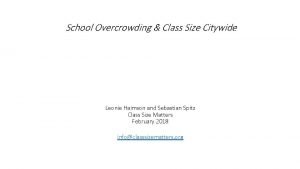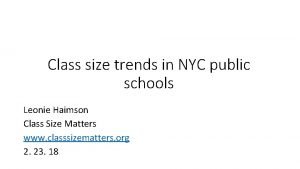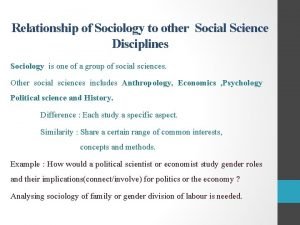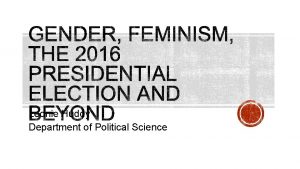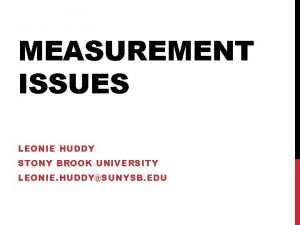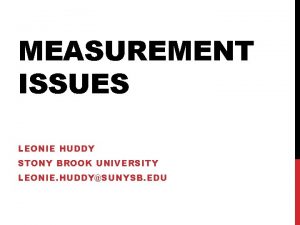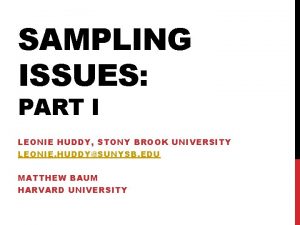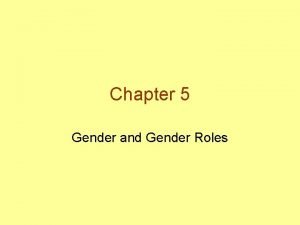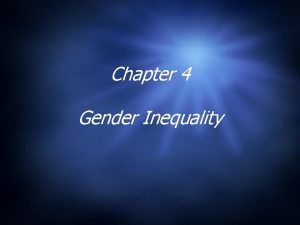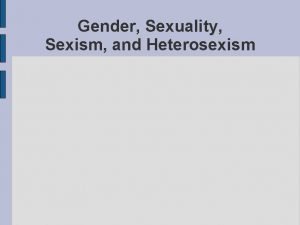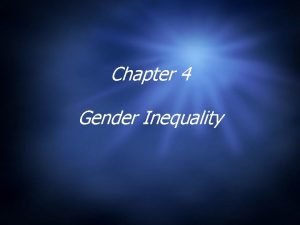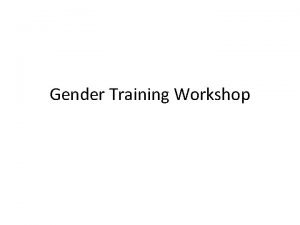Leonie Huddy Department of Political Science Large gender

















- Slides: 17

Leonie Huddy Department of Political Science



Large gender gap in 2016 • The Gender Gap (% women voting for Dem % men voting for Dem) = 13 pts. • Fewer men voted for Clinton than Obama; but the election outcome is not historically unprecedented • Raises questions about normalcy or extraordinariness of 2016

§ Gendered loyalties are complex § Men and women are highly interdependent, making gender a complex social category politically § Partisanship and vote choice are not simply grounded in gender § Many men are Democrats and many women are Republicans § There is a gender gap in partisanship but it is relatively modest in size (6 -12 % points in recent presidential elections)

Feminist gendered ideology § There is no widely accepted version of this concept. Typically measured by some mix of the following items: § Equal gender roles § Perceived inequality § Feelings toward feminists § An emotional bond with women § Have some of the best measurement in the 2012 ANES § 2012 ANES F 2 F (N=2, 054) and internet (N=3, 860) § Large oversamples of blacks and Latinos in both samples

2012 American National Election Studies § F 2 F (N=2, 054) and internet (N=3, 860) § Large oversamples of blacks and Latinos in both samples Feminist Identity and Antipathy (1 item) § Feeling thermometer rating of feminists (good distribution) Perceived Discrimination Against Women (4 items) § How serious a problem is discrimination against women in the United States? (modern sexism) Gender Resentment (2 items) § When women demand equality these days, how often are they actually seeking special favors? (from modern sexism) Importance of Female Political Representation (2 items) § How important is it to you that a woman is or is not elected President of the United States? Measurement Model: The four factors are distinct but form a strong common factor The structure is invariant across age, race, gender and interview mode


Distribution of Feminist Ideology by Gender (Kernel density plot) • 0 -1 scale overall; created by additively combining all four component scales (which are created in turn by additively combining their items) • Modest gender gap • Marked diversity among both women and men

Men Traditional Beliefs Women's Roles (non-traditional) Traditional Moral Values Religious Attendance Political Orientation Conservative-Liberal Ideology Personality Factors Authoritarian 0. 05 (0. 02) * -0. 18 (0. 02) ** Women 0. 02 (0. 02) -0. 13 (0. 02) ** 0. 01 (0. 01) 0. 00 (0. 01) 0. 14 (0. 02) ** 0. 16 (0. 01) ** -0. 02 (0. 01) * -0. 01 (0. 01) Open to Experience 0. 02 (0. 02) 0. 09 (0. 02) ** Agreeable 0. 08 (0. 02) ** 0. 05 (0. 02) * Education 0. 00 (0. 01) 0. 04 (0. 01) ** N R 2 2581 0. 31 2724 0. 32

This is drawn form an equation in which political ideology, traditional morality, and beliefs about the size of government are controlled.

Polarization Gender (female: feminism=0) -0. 11 (0. 05)* Ideology Strong Government 0. 36 (0. 02)** Traditional Moral Values -0. 26 (0. 03)** Religious Attendance -0. 04 (0. 02)* Conservative-Liberal Ideology 0. 67 (0. 04)** Group-Based Attitudes Racial Resentment (Non-Black) -0. 15 (0. 03)** Black X Resentment 0. 18 (0. 09)* Feminism (among men) 0. 29 (0. 07)** Female X Feminism 0. 18 (0. 09)* N R 2 5273. 56 Entries are regression coefficients with standard errors in parentheses.


Men Women 54 Trump 72 59 Romney 39 38 20 White College Men 40 59 51 34 46 Obama 33 0 52 Clinton 23 Obama 62 Romney 64 Clinton 45 Trump 60 White Non-College Men 80 39 0 10 20 30 White College Women 40 50 60 70 White Non-College Women 80

Women Men 100 90 90 80 80 70 70 60 60 50 50 40 40 30 30 20 20 10 10 0 0 A lot (57%) Some (15%) Clinton Not much (12%) Not at all (15%) Trump A lot (41%) Some (26%) Clinton Not much (15%) Not at all (16%) Trump

§ Partisans voted along partisan lines in 2016 § Feminism is a large part of that decision § The question concerns the additional role played by gender in 2016 § Did hostile sexism play an added role and drive support for Trump? § Were there heightened effects of feminism (among women and men)? § What does this mean for a future female political candidate? § Most likely to emerge within the democratic party § But may be easier to win if on the political right (decreasing the effects of sexism and snitfeminism)?

LEONIE. HUDDY@STON YBROOK. EDU
 Leonie bedeutung
Leonie bedeutung Strategic gender needs and practical gender needs
Strategic gender needs and practical gender needs Leonie born
Leonie born Leonie maßmann freund
Leonie maßmann freund Leonie voragen
Leonie voragen Leonie van lierop
Leonie van lierop Leonie thierfelder
Leonie thierfelder Leonie koerhuis
Leonie koerhuis Leonie busch
Leonie busch Leonie price
Leonie price Leonie cornips
Leonie cornips Leonie hartmann
Leonie hartmann Leonie haimson
Leonie haimson Leonie tensen
Leonie tensen Maths is my favourite subject
Maths is my favourite subject Uml political science
Uml political science Cyrus masroori
Cyrus masroori Relationship between political science and sociology
Relationship between political science and sociology





